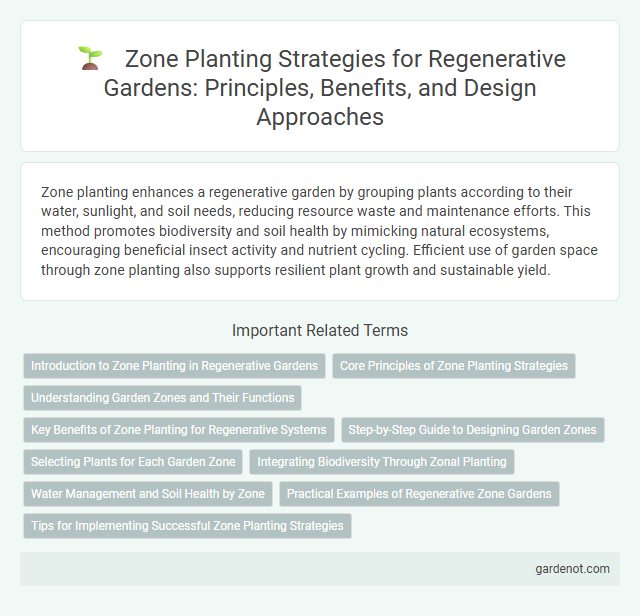Zone planting enhances a regenerative garden by grouping plants according to their water, sunlight, and soil needs, reducing resource waste and maintenance efforts. This method promotes biodiversity and soil health by mimicking natural ecosystems, encouraging beneficial insect activity and nutrient cycling. Efficient use of garden space through zone planting also supports resilient plant growth and sustainable yield.
Introduction to Zone Planting in Regenerative Gardens
Zone planting in regenerative gardens organizes plants based on their water, sunlight, and maintenance needs, enhancing resource efficiency and ecosystem health. This method creates microclimates that support beneficial soil microbes and promote biodiversity, contributing to soil regeneration. By grouping compatible species, zone planting reduces waste and improves plant resilience, making garden management sustainable and productive.
Core Principles of Zone Planting Strategies
Zone planting strategies in regenerative gardens prioritize organizing plants based on their function, water needs, and maintenance frequency to enhance ecosystem health and resource efficiency. Core principles include grouping plants with complementary growth habits and soil requirements to optimize nutrient cycling, water retention, and biodiversity. This approach minimizes waste, supports pollinators, and creates resilient microclimates that promote sustainable, low-input food production.
Understanding Garden Zones and Their Functions
Zone planting divides a regenerative garden into distinct areas based on plant needs and maintenance frequency, optimizing resource use and productivity. Each garden zone serves a specific function, from high-interaction zones near the home with herbs and vegetables to low-maintenance zones with native plants promoting biodiversity. Understanding garden zones enhances ecosystem resilience and supports sustainable cultivation by aligning plant placement with environmental conditions and human activity.
Key Benefits of Zone Planting for Regenerative Systems
Zone planting in regenerative gardens enhances resource efficiency by grouping plants with similar water, light, and nutrient needs, reducing waste and promoting healthier growth. It supports biodiversity by creating microhabitats that attract beneficial insects, pollinators, and soil organisms essential for ecosystem balance. This method improves soil structure and fertility over time through strategic plant placement, fostering sustainable soil regeneration and long-term productivity.
Step-by-Step Guide to Designing Garden Zones
Dividing a regenerative garden into distinct zones enhances efficiency by organizing plants based on their water, sunlight, and maintenance needs. Start by mapping your garden area, noting sun exposure, soil types, and access points to align plant placement with natural conditions. Assign high-maintenance plants like herbs to easily accessible zones, while placing drought-tolerant species in areas with less frequent care to optimize resource use and promote sustainable growth.
Selecting Plants for Each Garden Zone
Selecting plants for each garden zone involves analyzing sunlight exposure, soil type, and water availability to ensure optimal growth. Native species and drought-tolerant varieties are ideal choices for dry or sunny zones, while moisture-loving plants thrive in shaded or wetter areas. Incorporating layered planting with ground covers, shrubs, and trees enhances soil health and biodiversity across the regenerative garden.
Integrating Biodiversity Through Zonal Planting
Zone planting in regenerative gardens maximizes biodiversity by grouping plants according to their ecological functions and microclimate needs, enhancing resilience and ecosystem health. Native species are strategically placed in zones that mimic natural habitats, supporting pollinators, soil microbes, and wildlife while improving water retention and nutrient cycling. This method fosters symbiotic relationships among plants, promoting sustainable growth and reducing the need for external inputs.
Water Management and Soil Health by Zone
Zone planting in regenerative gardens strategically organizes plants according to their water needs and soil requirements, optimizing water management by minimizing waste through targeted irrigation methods. Soil health improves as plants in each zone contribute organic matter and support beneficial microorganisms, enhancing nutrient cycling and soil structure. This approach reduces runoff, promotes efficient water use, and fosters resilient ecosystems tailored to specific microclimates within the garden.
Practical Examples of Regenerative Zone Gardens
Regenerative zone gardening organizes plants based on their frequency of use and care, optimizing energy and resources in the garden. In Zone 1, practical examples include growing herbs and salad greens that require daily attention, while Zone 3 focuses on edible perennials and fruit trees needing less frequent maintenance. Integrating composting areas and rainwater harvesting systems nearby enhances soil fertility and conserves water, supporting sustainable plant growth in every zone.
Tips for Implementing Successful Zone Planting Strategies
Effective zone planting in regenerative gardens involves grouping plants based on their water, sunlight, and nutrient needs to optimize resource efficiency and plant health. Prioritize creating microclimates by placing shade-tolerant species under taller plants and drought-resistant varieties in sunnier, drier zones to minimize irrigation. Regularly monitor soil moisture and adjust plant groupings to enhance biodiversity and promote natural pest control within each zone.
Zone planting Infographic

 gardenot.com
gardenot.com